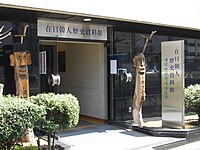lingvo.wikisort.org - Language
Zainichi Korean is a variety of Korean as spoken by Zainichi Koreans (ethnic Korean citizens or residents of Japan). The speech is based on the southern dialects of Korean, as the majority of first-generation immigrants came from the southern part of the peninsula, including Gyeonggi-do, Jeolla-do and Jeju-do.
This article relies largely or entirely on a single source. (June 2022) |
Due to isolation from other Korean speech-communities and the influence of Japanese, Zainichi Korean language exhibits strong differences from the standard Korean of either North or South Korea.
Languages among Zainichi Koreans
The majority of Zainichi Koreans use Japanese in their everyday speech, even among themselves. The Korean language is used only in a limited number of social contexts: towards first-generation immigrants, as well as in Chosŏn Hakkyo, (Korean: 조선학교; Hanja: 朝鮮學校, or Chōsen Gakkō; 朝鮮学校, "Korean School"), pro-Pyongyang ethnic schools supported by Chongryon.
Since most Zainichi Koreans learn Korean as their second language, they tend to speak it with a heavy Japanese accent. This variety of speech is called Zainichi Korean language, a name which, even when used by Zainichi Koreans themselves, often carries a critical connotation.[1]
Sounds
Vowels
While Standard Korean distinguishes eight vowels, Zainichi Korean distinguishes only five, as in Japanese.
Vowel jamo ㅏ ㅓ ㅗ ㅜ ㅡ ㅣ ㅐ ㅔ Standard Korean /a/ /ʌ/ /o/ /u/ /ɯ/ /i/ /ɛ/ /e/ Zainichi Korean /a/ /o/ /ɯ/ /i/ /e/
Initial consonants
In syllable-initial position, standard Korean distinguishes among plain, aspirated, and tense consonants, such as /k/, /kʰ/, and /k͈/. Zainichi Korean, on the other hand, distinguishes only between unvoiced and voiced consonants (/k/ and /ɡ/), as in Japanese.
Standard Korean Zainichi Korean Beginning of a word Elsewhere Plain /k/ Unvoiced /k/ or voiced /ɡ/, depending on speakers Aspirate /kʰ/ Unvoiced /k/ Geminated unvoiced /kː/ Tense /k͈/
There are no geminates after nasal consonants. Thus 앉자, /ant͡ɕ͈a/ in Standard, becomes /ant͡ɕa/, not /ant͡ɕːa/.
As in the North Korean standard, initial /ɾ/ or /n/ never change their values. 역사 /jəks͈a/ in South Korea is 력사 /ɾjəks͈a/ in North Korea, or /ɾjosːa/ among Zainichi Koreans.
Final consonants
Seven consonants occur in the final position of Standard Korean syllables, namely /p/, /t/, /k/, /m/, /n/, /ŋ/, and /ɾ/. In Zainichi Korean, again, those sounds are treated differently.
Standard Korean Zainichi Korean Plosives (/p/, /t/, and /k/) Followed by geminated consonants (i.e. /ɾjok/ followed by /sa/ becomes /ɾjosːa/) Nasals (/m/, /n/, and /ŋ/) /ɴ/ (as in Japanese) Flap (/ɾ/) /ɾ/
Grammar
Zainichi Korean grammar also shows influence from Japanese.
Some particles are used differently from the Standard Korean. For instance, "to ride a car" is expressed as chareul tanda (차를 탄다) in standard Korean, which can be interpreted as "car-(direct object) ride". In Zainichi Korean, the same idea is expressed as cha-e tanda (차에 탄다; "car-into ride"), just like Japanese kuruma ni noru (車に乗る).
Standard Korean distinguishes hae itda (해 있다, referring to a continuous state) and hago itda (하고 있다, referring to a continuous action). For instance, "to be sitting" is anja itda (앉아 있다), not ango itda' (앉고 있다), as the latter would mean "being in the middle of the action of sitting, but has not completed the action yet". Zainichi Korean, however, does not distinguish these two, as Japanese does not either; it uses hago itda form for both continuous state and continuous action.
Writing system
Zainichi Korean is not typically written; standard Korean is used as the literary language. For example, a speaker who pronounces the word geureona (그러나; "however") as gurona (구로나), will still spell the word in the former form. In much the same way, Standard Korean speakers retain the grapheme difference between ae ㅐ and e ㅔ, even though they may pronounce the two identically.
See also
- Koryo-mar
- Language contact
References
- Io, a magazine published by Choson Sinbo, had a report titled ここがヘンだよ「在日朝鮮語」 (Zainichi Korean language is strange in these ways), criticizing this variety of Korean, which can't be called urimal (literally "our language") anymore".
Further reading
- Yim Young Cheoul, 在日・在米韓国人および韓国人の言語生活の実態 ("Realities of language lives among Zainichi Koreans, Korean Americans, and Koreans"), 1993. (ISBN 4-87424-075-5)
- Shinji Sanada, Naoki Ogoshi, and Yim Young Cheoul, 在日コリアンの言語相 ("Language aspects of Zainichi Koreans"), 2005. (ISBN 4-7576-0283-9)
- Shinji Sanada and Yim Young Cheoul, 韓国人による日本社会言語学研究 ("Sociolinguistic study of Japan by the Korean"), 2006. (ISBN 4-273-03432-8)
External links
- (in Japanese) 在日朝鮮語 (Zainichi Korean language)
Другой контент может иметь иную лицензию. Перед использованием материалов сайта WikiSort.org внимательно изучите правила лицензирования конкретных элементов наполнения сайта.
WikiSort.org - проект по пересортировке и дополнению контента Википедии


